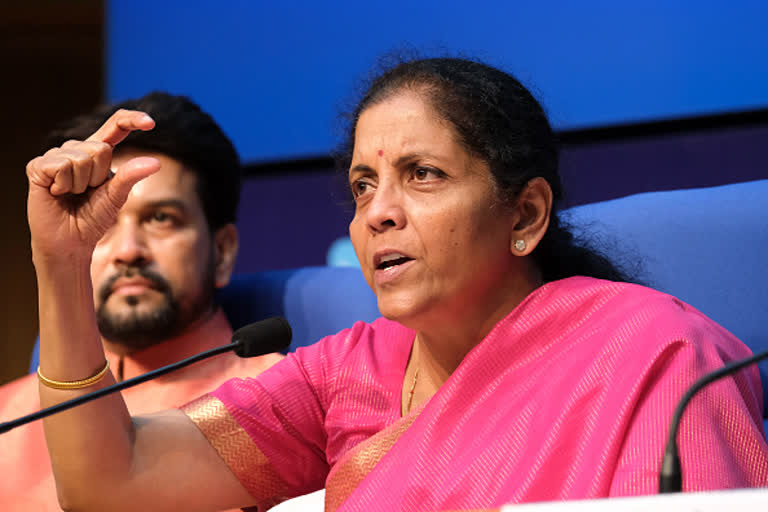Hyderabad: The much awaited Budget for the financial year 2019-20 was presented by the Finance Minister Nirmala Sitharaman in the Parliament. This budget is largely a practical one, dictated by the economic developments at home and abroad.
In the wake of economic growth slowing down to 6.8 percent during 2018-19 and the unemployment being at an alarming level, the top priority of the Government has been to spur economic growth and generate jobs.
While there are measures that had drawn appreciation there are some policy areas that could have been better.
A Budget that Batted for Growth:
The announcement of an additional Rs 1.5 lakh tax relief on home loan for purchase of a house up to Rs 45 lakh is a progressive step as it has the potential to create demand in the housing sector, which in turn results in a rising demand for the construction materials. This step would also improve the employment prospects in the construction sector marginally.
Read more:Exclusive: Nirmala Sitharaman says hike in cess on petrol & diesel not likely to affect inflation
An attempt is also made to raise the ‘animal spirits’ of the markets by announcing assuring policies. The announcement to purchase high-rate pooled assets of Non-Banking Financial Companies (NBFCs) amounting to Rs 1 lakh core in this Financial Year and the proposal of huge rescue package of Rs. 70,000 crores to recapitalise public sector banks and the removal of the angel tax are the measures that could send positive ripples in the financial markets and provide fertile ground for a revamped credit creation and a positive investment climate, which in turn would promote economic growth in the medium run.
An attempt is also made to nurture the Micro, small and medium enterprises (MSMEs), as this sector is having the potential to boost job creation. Measures like facilitating easy access to loans up to ₹1 crore for MSMEs, and contemplating a national payment gateway for MSMEs to ease payment woes are positive steps towards strengthening this sector. These efforts are expected to boost economic growth and improve the employment prospects.
Boosters to Investment:
While the Government’s announcements to relax the local sourcing norms for the single-brand retail sector, opening up of the sectors like aviation, insurance, animation AVGC and media for FDI, allowing FIIs & FPIs investment in debt securities issued by NBFCs, rationalizing the KYC norms for FPIs to make it more investor-friendly are positive and progressive steps.
However, there is even larger scope for improvement on this front. For instance, bringing clarity on the clause of Substantial Ownership and Effective Control (SOEC), that bars any foreign investor from taking complete control of the operations of the airline and be run by a board that has two third members as Indian, could go a long way in attracting more buyers for Air India.
Many such areas and clauses in the rule books, that stands as a hindrance for attracting investments need to be identified sector wise and addressed in a time bound manner. On the other hand the current dispensation is pretty clear on its stance on disinvestment and announced to modify its modify present policy of retaining 51% stake in Public Sector Undertakings (PSUs). While it decided to continue with strategic divestment of select CPSEs, the disinvestment target has been revised to Rs 1.05 lakh crore for the fiscal year 2019-20. However, this target appears to be challenging, given the investment climate, globally.
The Way Ahead:
While the policy intentions of the Union Government aims at reviving the present economic growth rate and raise it to 8 per cent in this fiscal year and set the grand target of making the country, a $5 trillion economy by 2025, there are challenges on the way.
The major challenge will be the fiscal constraints. The Economic Survey, released just a day before the Budget aimed at bringing down the fiscal deficit to 3 per cent by March 2021. However, given the growth and tax revenue constraints and the Union Government’s decision to go for larger borrowings, the rising crude oil prices, realizing this fiscal target is an uphill task which will be taking a toll on the fiscal fabric of the country.
Moreover, in the wake of dampened global and domestic growth and slowing economy, the tax collections and the revenue buoyancy could be mellowed down.
It is in this context there is a need to attract investments and improve the non-tax revenue component of the Government. Given this backdrop, there is a need for the huge target of disinvestment and the road blocks to both investment and disinvestment need to cleared on priority basis. At a time when savings and tax revenues are expected to be low, investments are the saviours and it is the imperative of the policy makers to provide the eco system that attracts and sustain the investments. Budget 2019 made an attempt in that direction.
(Written by Dr. Mahendra Babu Kuruva, Assistant Professor at H.N.B. Garhwal Central University, Uttarakhand)



